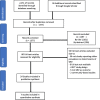Gender-based violence among female youths in educational institutions of Sub-Saharan Africa: a systematic review and meta-analysis
- PMID: 30803436
- PMCID: PMC6388495
- DOI: 10.1186/s13643-019-0969-9
Gender-based violence among female youths in educational institutions of Sub-Saharan Africa: a systematic review and meta-analysis
Abstract
Background: Gender-based violence is a public health issue. The prevalence of gender-based violence is high in Sub-Saharan Africa. Therefore, this study aims to produce an overall summary estimate on the prevalence of gender-based violence according to different types and its risk factors among female youths in educational institutions of Sub-Saharan Africa.
Methods: Studies published in English between 2000 and 2017 were identified by searching electronic databases such as MEDLINE, CINAHL, EMBASE, PsychINFO, and other relevant data bases. Three reviewers independently extracted the data and assessed the quality of studies using the Loney guidelines. The pooled prevalence of gender-based violence and type of GBV was computed using STATA software version 14, and between studies heterogeneity was tested using Cochran's Q test and I2 statistics. Meta-regression analyses were done to identify factors associated with GBV estimates.
Results: A total of 1377 articles were produced from different databases, and a final 24 articles were included in the review. The overall prevalence of gender-based violence ranged from 42.3% in Nigeria to 67.7% in Ethiopia. The lifetime prevalence of sexual violence ranged from 4.3 to 76.4%, physical violence ranged from 7.4 to 66.1%, and emotional violence prevalence ranged from 26.1 to 50.8%. The overall pooled prevalence of lifetime GBV (n = 7 studies) was 52.83% [95% CI 39.54-65.90%, I2 = 99.1, P < 0.00]. The pooled estimate of sexual violence (n = 23), 26.22% [95% CI 19.48-33.57%, I2 = 99.39, P < 0.00], physical violence (n = 9), 18.86% [95% CI 10.96-28.3%, I2 = 98.98, P < 0.00], and emotional violence (n = 5), 27.06% [95% CI19.57-35.28%], I2 = 97.1, P < 0.00]. The review showed that gender-based violence was significantly associated with place of residence, witnessing parental violence, substance abuse, marital status, and educational status.
Conclusions: The overall prevalence of overall gender-based violence, sexual, physical, and emotional violence was high in Sub-Saharan Africa. The lowest prevalence of GBV was observed in Nigeria, and it was highest in Ethiopia. However, the results should be interpreted with caution because of high between studies heterogeneity. Evidence from the review part revealed GBV was significantly associated with place of residence, witnessing parental violence, substance abuse, marital status, and educational status. The Sub-Saharan African countries should develop a comprehensive educational institution-based prevention strategy and effective interventions to mitigate gender-based violence and to specifically achieve the SDG5.
Systematic review registration: PROSPERO CRD4201073260.
Keywords: Educational institutions; Female; Gender-based violence; Meta-analyses; Sub-Saharan Africa; Systematic review; Youth.
Conflict of interest statement
Ethics approval and consent to participate
Not applicable
Consent for publication
Not applicable
Competing interests
The authors declare that they have no competing interests.
Publisher’s Note
Springer Nature remains neutral with regard to jurisdictional claims in published maps and institutional affiliations.
Figures





References
-
- United Nations: Secretary-general’s in-depth study on violence against women. United Nations General Assembly, 61st Session: Advancement of Women. In.: Division for the Advancement of Women, Department of Economic and Social Affairs; 2006.
-
- World Health Organization . WHO multi-country study on women’s health and domestic violence against women: summary report of initial results on prevalence, health outcomes and women’s responses. 2005.
Publication types
MeSH terms
LinkOut - more resources
Full Text Sources
Medical

